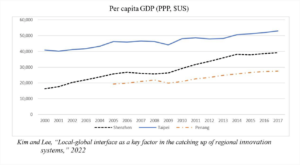February 23rd, 2024
Via Project Syndicate, an interesting comparison of the success of foreign direct investment in China and Malaysia:
Few experts doubt that foreign direct investment can bolster economies by bringing in critical know-how, expanding local production, and creating jobs. It is no surprise, therefore, that attracting FDI has long been a top priority for developed and developing economies alike, as reflected in the generous incentives included in the United States’ Inflation Reduction Act. But, when it comes to driving economic growth and development, FDI has a mixed record.
To understand why, it is worth looking at the contrasting experiences of Penang, Malaysia, and Shenzhen, China. Thanks to its strategic location, low labor costs, and favorable taxes, Penang was among the first Asian cities to attract investment from multinationals, including through its Free Industrial Zone, established in 1972. Later, Shenzhen also began courting FDI, establishing its Special Economic Zone in 1980 – and quickly became a hub of labor-intensive manufacturing.
But, when it comes to converting that early FDI into income growth and technological upgrading, Shenzhen has been far more successful than Penang. As the chart shows, in 2017, Shenzhen’s per capita GDP stood at $39,245 in purchasing-power-parity terms (72% that of the US), compared to just $27,569 (about 50% that of the US) in Penang. Whereas Penang has been slow in growing out of low-value-added manufacturing, Shenzhen has cultivated a thriving high-tech sector. The number of US patents registered to inventors with an address in Shenzhen increased from zero in the 1990s to about 2,500 in 2017, whereas Penang had reached just 100.
One might be tempted to attribute this divergence to the size of the national economy: surely China’s massive market and labor force, huge amounts of state investment, and abundance of dynamic cities helped Shenzhen along. But Taipei – located on the island of Taiwan – has also converted FDI into rapid growth and technological progress since the 1960s.
The real explanation of Shenzhen’s success lies in firm ownership. Since those early FDI-dominated days, Shenzhen has become increasingly dominated by innovative indigenous firms, such as BYD, DJI, and Tencent. In 2005, two Taiwan-based companies – led by Foxconn (also known as Hon Hai Precision Industry Co.) – were Shenzhen’s top two firms by patent. By 2015, Chinese-owned companies filled the entire top ten, with ZTE and Huawei leading the pack. Today, Shenzhen is among China’s most advanced cities, and it now appears to be surpassing Hong Kong.
This was no accident. China’s government made the promotion of locally owned firms a high priority and introduced supportive industrial and innovation policies, including public-private research-and-development initiatives and venture capital. It even created public-private R&D consortiums, which facilitate technology transfer to local manufacturers. Without these policies, Huawei probably would not exist, at least not as we know it today.
Early on, Huawei sold telephone switches imported from Hong Kong. Eventually, it transformed itself into a high-tech manufacturer that relied on in-house R&D, rather than forming a joint venture with a multinational corporation. The diffusion of knowledge from a foreign firm, Shanghai Bell, to Huawei – facilitated by a public-private R&D consortium – proved integral to this shift.
Nurturing dynamic local firms was never a policy goal in Penang. As a result, the economy remains dominated by American multinationals, which locate mostly lower-value-added activities in Malaysia, while keeping higher-value-added activities, such as R&D, at home. Big US firms, such as Intel and Motorola, account for 50-70% of the top patent assignees in Penang, while the share for Malaysian firms has declined from 20% in the 2000s to zero since the mid-2010s.
What FDI in Penang did achieve was to foster human-capital development. In 1989, the Malaysian government established the Penang Skills Development Centre to ensure that workers had the skills multinationals demanded. This well-trained workforce, together with strong supply chains, helps to explain why many multinationals have stuck around, even as local wages have risen. In other words, the city still has plenty of potential. Nonetheless, the lack of indigenous innovation has impeded Penang’s development, just as the emergence of such innovation has accelerated Shenzhen’s.
These contrasting development stories hold an important lesson for developed and developing countries alike. Attracting FDI is important, but making the most of it requires interventions that support a long-term process of knowledge transfer and indigenous innovation. If the US hopes to lead the industries of the future, perhaps it should consider creating Shenzhen-style public-private R&D programs.
Focusing primarily on The New Seven Sisters - the largely state owned petroleum companies from the emerging world that have become key players in the oil & gas industry as identified by Carola Hoyos, Chief Energy Correspondent for The Financial Times - but spanning other nascent opportunities around the globe that may hold potential in the years ahead, Wildcats & Black Sheep is a place for the adventurous to contemplate & evaluate the emerging markets of tomorrow.

